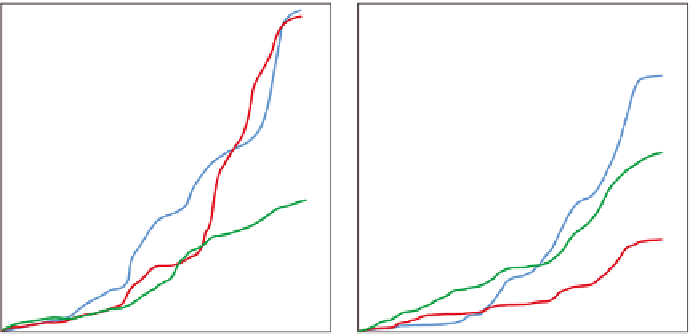Geoscience Reference
In-Depth Information
40
Low nutrient (× 10
3
)
High nutrient (× 10
4
)
35
Ref
A2
A2 + 50%
Ref
A2
A2 + 50%
30
25
20
15
10
5
0
0
200
400
600
800
1000 1200 1400 1600 1800
Day
0
200
400
600
800
1000 1200 1400 1600 1800
Figure 6.6
Cumulative changes in chlorophyll
a
concentration (average of 4 replicate
mesocosms) during the first 4 years (number of days) of the Danish mesocosm
experiment involving two levels of nutrient loading (left, low; right, high). Green line
gives data for ambient temperature, blue line for the A2 scenario of IPCC (2007) and red
line for the A2+50% scenario.
Changes in seasonality were also evident. In the low-nutrient mesocosms, two
plant species,
Potamogeton crispus
and
Elodea canadensis
, became dominant at
the raised temperature. Growth of
P. crispus
started earlier in the heated
mesocosms than in the controls (Fig. 6.7) in all four growth seasons studied and
reached a peak earlier in the heated mesocosms (T.L. Lauridsen
et al
. unpublished
data). Controlled growth experiments in pots confirmed this pattern. However,
there was a complicated pattern of effects. For
E. canadensis
, growth in pots was
independent of temperature in both spring and summer. Growth potential in
autumn, in contrast, was higher under the A2+ scenario at both low and high
nutrient concentrations compared with the control mesocosms. In winter, growth
was almost zero, except in the A2+ mesocosms where a slight growth was
recorded. Higher temperatures also increased the likelihood of filamentous algae
becoming dominant in the experimental ponds. Finally, earlier emergence of
flying insects and earlier reproduction of snails were recorded (T.B. Kristensen
unpublished data).
Oxygen in the mesocosms was continuously measured, which allowed the
calculation of gross and net primary production (GPP and NPP, respectively) and
ecosystem respiration (ER) from changes in concentrations over 24-hour cycles.
Net ecosystem production (NEP) was calculated as the difference between GPP
and ER. Seasonal variation in GPP and in daytime ER followed the variations in
light and temperature, being about 10 times higher during summer than in winter.
At ambient temperatures, the addition of extra nutrients had only a minor effect
on GPP and ER, and the overall seasonal dynamics remained similar at low and
high nutrient loading. Only during summer did nutrient addition lead to
higher rates. That GPP and ER were not greatly affected by nutrient loading










































































Search WWH ::

Custom Search